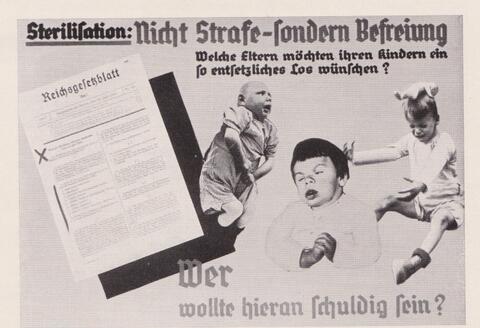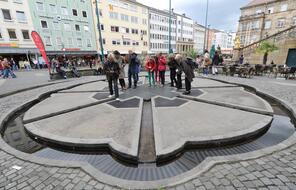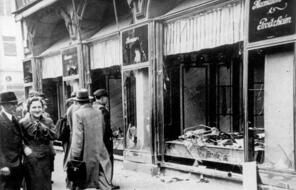Breeding the New German "Race"
In 1925, Adolf Hitler wrote in Mein Kampf, “Everything we admire on this earth today—science and art, technology and inventions—is only the creative product of a few peoples and originally perhaps one race [the “Aryans”]. On them depends the existence of this whole culture. If they perish, the beauty of this earth will sink into the grave with them.” From the start, the Nazis were determined to ensure the strength and purity of the “Aryan” race. They believed, according to historian Richard Evans, that “the strong and the racially pure had to be encouraged to have more children, the weak and the racially impure had to be neutralized by one means or another." 1
One way the Nazis encouraged “strong and pure” Aryans to have more children was through the “marriage loan” program. Beginning in June 1933, the government made interest-free loans of up to 1,000 marks available to young couples who intended to get married, provided that they met certain criteria. One criterion was that both the man and woman could prove their “Aryan” heritage. Another criterion was that the bride had to have been employed for six months in the two years preceding the marriage, and she had to promise to leave her job and stay home until the loan was paid off. This requirement was intended to encourage working women to leave the job market and make more jobs available to men. Finally, for each child born to the couple, a quarter of the loan amount was forgiven. Therefore, if the couple had four children, they would not have to repay any of the original loan amount. In this way, the program encouraged healthy “Aryan” couples to have more children and reinforced what the Nazis believed was the proper role of women in society. 2
Nazi Eugenics Exhibition Poster

Nazi Eugenics Exhibition Poster
This poster from a eugenics exhibition in the 1930s reads, “Sterilization is Liberation, Not a Punishment.” Three handicapped children are also pictured with the caption, “Who would want to be responsible for this?”
The Nazis regarded the breeding of a superior race, encouraged by policies such as the marriage loan program, as “positive eugenics” (see reading, Breeding Society’s "Fittest" in Chapter 2). They also practiced “negative eugenics” by preventing people they considered genetically inferior from reproducing. A new law announced in July 1933 was the first step in that process. It permitted the government to sterilize anyone who suffered from so-called “hereditary” illnesses such as “feeble-mindedness,” schizophrenia, manic-depressive illness, genetic epilepsy, Huntington’s chorea, genetic blindness, deafness, and some forms of alcoholism.
The idea was not a new one. Sterilization laws existed in several other countries at the time, including the United States. Between 1907 and 1930, 29 US states passed compulsory sterilization laws, and about 11,000 women were sterilized. Many states also had laws that banned marriages between white people and people of color—including African Americans, Native Americans, and Asians. Both sets of laws were prompted by a desire to eliminate “strains that are a burden to the nation or to themselves, and to raise the standard of humanity by the suppression of the progeny of the defective classes.” 1 (see reading, Attitudes Toward Life and Death in Chapter 4). The Nazis took that goal much further than Americans ever did.
Gregor Ziemer, an American educator, observed the results of the law when he toured a German hospital where sterilizations took place. A guide informed him that the patients were “the mentally sick, women with low resistance, women who had proven through other births that their offspring were not strong. They were women suffering from defects . . . some were sterilized because they were political enemies of the State.” He was told, “We are even eradicating color-blindness in the Third Reich. . . .” When Ziemer asked who made the decisions, the guide boasted, “We have courts. It is all done very legally, rest assured. We have law and order.” 2
To enforce the law, the Nazis created health office departments for “gene and race care” and set up “genetic health courts.” There, doctors and lawyers worked together to decide who would be sterilized. The individual had no say in the decision. In the first four years after the law was passed, the Germans sterilized over 50,000 people. By the end of the Nazi regime in 1945, they had sterilized nearly 360,000. 3
Connection Questions
- After studying government-sanctioned violence, sociologist Irving Horowitz concludes, “The precondition for mass extermination was engineered dehumanization: the conversion of citizens into aliens." 6 What is dehumanization? What evidence of the intentional process of dehumanization can you find in this reading?
- How do you think old prejudices about the disabled and “less worthy races” affected the way people responded to the new sterilization law? How do you think the fact that the law was the work of doctors and professors affected the way people responded to it? How might the language used to describe such laws have influenced the way people responded to them?
- What was the purpose of the sterilization law? What is the danger in giving the government the power to control who can have children?
- 1Franz Boas, “Eugenics,” Scientific Monthly 3, no. 5 (1916): 476–77.
- 2Gregor Ziemer, Education for Death: The Making of the Nazi (Oxford, UK: Oxford University Press, 1941), 19.
- 3Richard J. Evans, The Third Reich in Power (New York: Penguin, 2005), 508.
- 6Irving Louis Horowitz, Taking Lives: Genocide and State Power, 3rd ed. (New Brunswick, NJ: Transaction Books, 1980), 302.
How to Cite This Reading
Facing History & Ourselves, “Breeding the New German "Race"”, last updated August 2, 2016.













